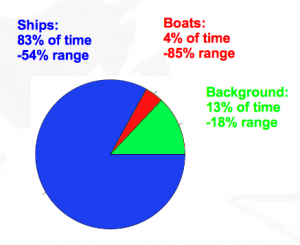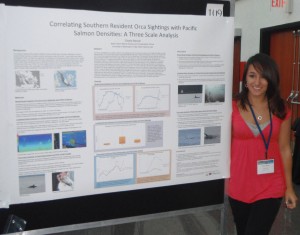Marine water workshop – Salish Sea situation in 2013
Notes by an oceanographer from an upper trophic (orca) perspective during the outer-coast/less-local/more-regional portion of the annual meeting of the Marine Waters Monitoring Workgroup of the Puget Sound Ecosystem Monitoring Group (PSEMP) at APL/UW on 3/28/14. This meeting is a rare effort and opportunity to synthesize ocean observations from the previous year and across the Salish Sea and outer coast of the Pacific Northwest region (with an over-emphasis on Puget Sound). I was not able to stay for the rapid-fire talks related to plankton & pathogens (e.g. harmful algal blooms) or water quality.
Freshwater inputs — Ken Dzinbal
In long-term medians from rivers across region, the overall long-term seasonal pattern is a dry period in Sep-Oct (extending into late fall for some rivers), then a wet spring with big storm pulses Feb-June. In 2013, Fraser mean daily discharge at Hope (above tidal influence) peaked in late May, ~1 month earlier than historic median.
Fred Felleman mentioned that 2013 was a terrible year for Fraser river Chinook and a bumber year for Columbia Chinook, and that the Southern Resident Killer Whales (SRKWs) responded one would expect for the “best salmon samplers on the planet” — they were rarely sighted in inland waters and tracked often on the outer coast near the Columbia river mouth. PSC Fraser panel is a good source of historic data on Fraser flows.
Boundary conditions & water masses — Skip Albertson
Less upwelling in Aug/Sep; SW winds! Usually we have N winds and upwelling in September, but we almost had down-welling due to unusual winds out of the southwest.
We looked at Pacific Decadal Oscillation (PDO), and index that changes slowly. Initially there was colder water up against the coast, but then offshore waters got warmer and warmer. Overall in 2013, the PDO index was slightly lower than long-term means.
Cha’ba mooring (offshore Washington) — John Mickett
Temperature-Salinity plot for all of Puget Sound shows median values near 11 oC and 30 psu with low (6.5 mg/l) dissolved oxygen (DO) levels. This suggests a stronger-than-usual influence of oceanic water. Christopher Krembs pointed out that the goal is to start looking at Puget Sound water properties in terms of water masses that may traverse the different basins, rather than
The big story on the outer coast in 2013 was the hypoxia. John showed pictures of many dead Dungeness crabs washed up on Ruby Beach. Looking at data from 3 and 84 meters, you see phytoplankton blooms (chlorophyll concentrations up ~20 micrograms/l). In mid-August we saw DO levels drop to ~1 ml/l a level which stresses or kills organisms. At about the same time we saw very unusual warm surface water temperatures (up to 16-18 oC, well above the long-term means of ~12 oC) which were due to the wind reversals that led to stratification and subsequent solar-heating.
Upwelling comes from 30-40m (ref Ryan McCabe) and has much higher DO than what we saw. That’s why we think these low DO events in the shallow water were advected horizontally, having formed somewhere else.
End of May (5/31) and beginning of July (7/1) sees Columbia River plumes in surface waters. Are these related to court-ordered dam releases?
San Juan channel — Jan Newton (slides from 2013 research apprentices)
North station off NE San Juan Island; South station just south of Cattle Pass (tends to picks up Pacific Ocean influence)
Normally, Fraser plume is advected south in the summer and north in the winter, with associated up-/down-welling changes. It creates a strong pycnocline near 30-40m.
Redfield AC (1950) Note on the circulation of a deep estuary: the Juan de Fuca-Georgia Straits
In 2013, TS plots from Centennial calibrated CTD show that 2012 was an anomalously cold year. The 2013 T-S ranges were +1 oC higher, and slightly fresher. In mid-October the cold 2012 water was ~0.5oC lower than long-term medians.
PDO shift from + to – values near 2007 correlates with warmer to cooler transition in inland water temperatures. There are initial hints that during the inland cooler periods we see higher seabird (and other upper trophic level animal?) populations.
Harbor porpoise acoustic studies — Aileen Jeffries
CPODs and land-based visual observations. CPODS for 3 years in Burrows Pass, also at Biz Point and now at PTMSC
Harbor porpoise population plummeted in 50s, were nearly gone in 70s and now seem to be on a rebound.
Acoustic detections from Burrows typically show nighttime peaks of ~50 minutes/hour and 1/10th those levels during the day.
Click rates of 400-600 clicks/s during foraging; about 20 clicks/s otherwise (histogram).
Seasonally they are less present during the summer (low in May/June) than winter at Burrows Pass (based on visual sightings).
Primary prey is herring, smelt, and sand lance. Florian Granger (did PhD in Europe on harbor porpoises) says that they often travel in groups of 3.
What about anchovies and the possible decadal dynamics on the outer coast?
John Mickett asked why the diurnal pattern is so strong in Burrows Pass. Aileen thought that they were targeting animals that follow the vertical migration of zooplankton to surface waters at night, but also suggested day-time boat interference might be a factor (but implied they had not quantified boat traffic). Dzinbal suggested that squid might be following the zooplankton…
Read More




 Twitter
Twitter LinkedIn
LinkedIn Facebook
Facebook